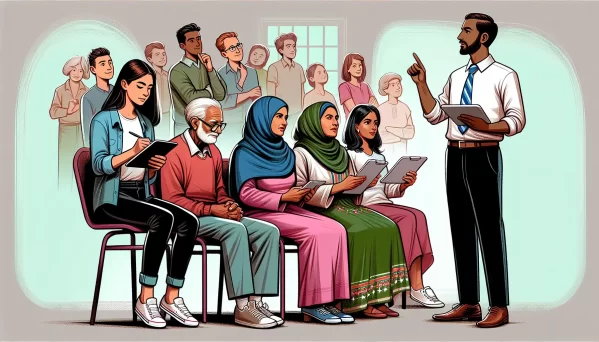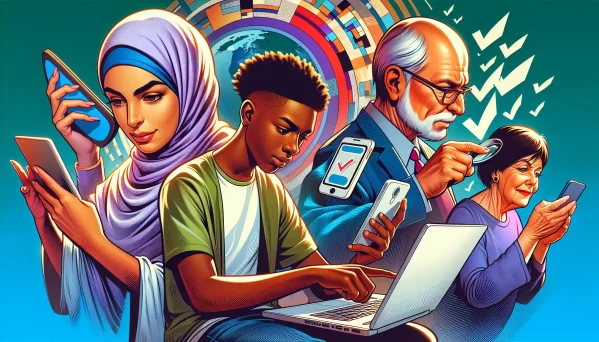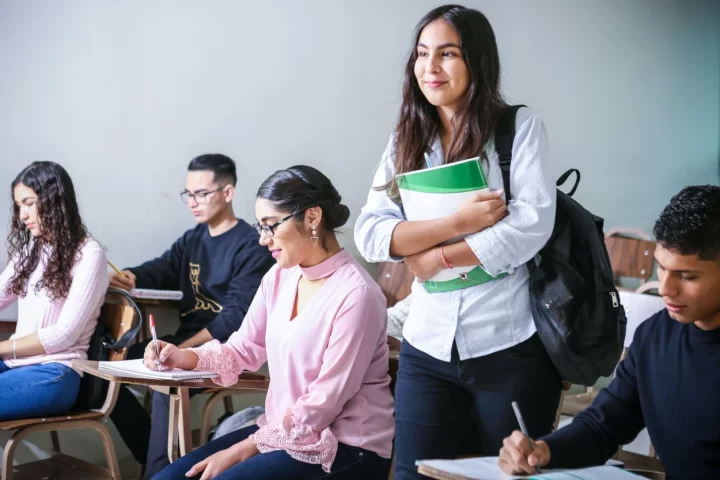Seeking clarity on voters’ education? Cut through the confusion with this no-nonsense guide. Designed to empower you and other voters alike. Armed, with the essentials of the electoral process. Learn what truly matters when casting your vote, from understanding candidate policies to navigating the mechanics of election day.
Key Takeaways
Voter education is vital for an informed population, empowering every Joe and Jane to not just throw confetti in the ballot box but make choices that matter. Strongly, guided by knowledge of the candidates, their policies, and your voter rights.
The U.S. election isn’t a surprise birthday party; it’s a well-orchestrated dance. A dance with steps like voter registration, understanding the electoral college, and primaries. Every citizen needs to feel they can stride with confidence to a safe, secure, and trustworthy ballot box.
In the digital dojo, media, and tech are the senseis of voter education. How? By transforming each social feed swipe or each debate-watch party into a chance to be a well-informed voter. Not being swayed by just the winds of charisma and false information.
Table of Contents
- Understanding Voter Education
- Are You Aware of What is on the Line During this Election?
- The Expansion of Social Platforms Online
- The Mechanics of Elections: What Every Voter Should Know
- Empowering Specific Voter Groups
- Leveraging Media and Technology in Voter Education
- Building a Culture of Participation
- Summary
- Frequently Asked Questions
Understanding Voter Education

Imagine entering the voting booth ready to exercise your right to vote with a ballot in hand. Pause, for a moment!
Are You Aware of What is on the Line During this Election?
Familiar with the candidates? Know how to correctly fill out your ballot? This is precisely where efforts in voter education play an essential role. It equips potential voters with all they need to know to make choices based on solid information.
Nevertheless, there’s more to voter education than merely knowing how to mark a ballot. It encompasses an understanding of:
The structure of political governance
The ideologies and objectives of various parties
How each candidate differs from one another
The significant impact that your vote has
Voters Making Well-informed Decisions
It’s about guaranteeing that every eligible voter is educated on their rights, which allows them to fully participate. As well as, voters making well-informed decisions on Election Day.
Now let’s consider for a moment. Who drives these educational endeavors? These programs are aimed at how voters understand the inner working parts like:
Agencies run by government officials
News outlets and media organizations
Political factions themselves
-Societal groups not affiliated directly with government institutions
-Institutions operating internationally
-Voter empowerment campaigns such as the Nonprofit Voter Empowerment Project
The Expansion of Social Platforms Online
The expansion of social platforms online has facilitated greater access to electoral data thereby shaping election outcomes through spreading awareness among larger populations.
Above all else, the purpose behind educating voters is to empower people. This is especially urgent for those voters who are eligible to vote but less likely to cast a ballot.
No Citizen Left Behind
Ensuring that no citizen’s background within the law or status hinders their capacity to be adequately prepared when it comes time to cast an effective ballot. Instead of accepting simply having ‘MANY’ informed electorate members.
To demand ‘EVERY SINGLE’ participant within a democracy is equipped with the necessary knowledge before heading to the polling station. So remember next time you venture inside the place where votes are counted; Your voice holds power because casting your vote reflects speaking up! So be heard.
The Mechanics of Elections: What Every Voter Should Know
Recognizing the important role of voter education, we should examine how the U.S. election process unfolds comprehensively. It entails more than simply placing a ballot on election day. It’s an entire sequence that includes:
Grasping the function of the Electoral College
Navigating primaries and caucuses
Attending Local Rallies or National conventions
The path to casting a vote begins well before voters reach the voting booth. Typically, candidates initiate their campaigns about a year in advance. This is to assemble their staff, promote awareness among the community of potential supporters, and secure campaign funds.
Eligible Citizens
What is required from voters themselves? The journey for eligible citizens also follows a set schedule that begins with registering to vote. In my home state of Arizona, you can register to vote via the Secretary of State’s website. As well as, the Service Arizona, AZ MVD Now Portal. Any Department of Motor Vehicles location. You may visit your County Recorder’s Office and fill out a registration form in person.
Details regarding registration methods and specific guidelines for voting on election day can be found on the websites of various election management bodies for your state. Including public announcements and events.
Not Prepared to Play
Understanding how you vote is crucial in equipping voters with confidence and increasing overall participation rates in elections. You’re not prepared to play unless you understand the rules completely! This underscores why concerted voter education efforts like Arizona’s CLEAN ELECTIONS COMMISSION are indispensable: they supply prospective voters with all the necessary information to participate knowledgeable in all topics.
VOTING IN PERSON
Early Voting
Polling Place
Vote Center
ID at the Polls
Thus, when stepping into your local polling station on election day; keep in mind, that each mark made by your pen isn’t just another piece filled out on paper. Rather it symbolizes active engagement within our democratic system where every choice helps carve out our nation’s trajectory.
Empowering Specific Voter Groups
Access to the electoral process is not evenly distributed among all voters. Various factors, including race, age, income level, education, and ability, can result in disparities in political participation. It’s extremely important to tackle these underlying issues and enhance the empowerment of specific voter demographics.
Employing an intersectional approach in voter education takes into account multiple social identities like race, gender, and disability status to pinpoint individuals most likely to be disenfranchised from voting—particularly within minority groups.
Ensuring that everyone has access to information through comprehensive coverage with voter education campaigns like in Arizona.
Genuinely Inclusive Democracy
Another example in Texas – The Texas Secretary of State Jane Nelson Promotes Voter Education and is partnering with Texas Woman’s University to Educate Students on ID Requirements for the 2024 Elections. This represents another critical strategy for fostering a genuinely inclusive democracy by reaching out, particularly to those who are marginalized or at a disadvantage.
Nonpartisan organizations play an instrumental role here. They strive towards boosting turnout among historically underrepresented segments such as communities of color, lower-income citizens, youth, and younger people.
Resources such as the ‘You Don’t Need A Home To Vote’ guidelines also assist in addressing barriers related to registration and engagement for those dealing with homelessness or financial constraints.
Can someone who is homeless register and vote?
Yes. Persons experiencing homelessness can register and vote in all 50 states.
Stringent Voter ID Laws
Tools designed for voter identification help deal with stringent voter ID laws which often and disproportionately affect populations like voters from ethnic minorities or immigrants that are legally allowed to vote.
So, picture this: in the wacky world of American politics, every state has its own set of rules for proving you’re you at the ballot box.
From the simple “Hey, it’s me!” to whipping out your best driver’s license photo, it’s a wild ride. But hold onto your hats, folks, because these rules aren’t just a walk in the park – they’re a rollercoaster of controversy that’s been looping for many decades! So buckle up and bring your ID – it’s gonna be a bumpy (and often hilarious) ride through the voting booth!
Here is a Little Fact Dropping For You.
Alright, so here’s the deal: thanks to the Help America Vote Act of 2002 (HAVA), Anyone remembers (Floridas Hanging Chads?) Oops, I digress. First-time voters in federal elections across the good ol’ U.S. of A. gotta flash some ID if they signed up via snail mail. But hold your horses! If you sauntered right up to that registration desk in person, no need to whip out your driver’s license – you’re all good!
HAVA minimum
Now, brace yourself, because some states like to jazz things up beyond the HAVA minimum. Picture this: you stroll into the polling station, ready to cast your vote for the next neighborhood pickle mascot, and what do they want?
Your name, your address, your John Hancock – the works!
And let’s be real here, trying to pull a fast one and impersonate a registered voter? That’s not just a whoopsie-doodle, it’s felony-grade shenanigans in most states! So remember, folks, keep it real at the polls – no funny business allowed!
The overarching aim remains clear: guaranteeing that every person eligible has the opportunity both practically and legally secured—to participate freely in their right to vote so that each voice may contribute effectively within our country and democratic framework.
Leveraging Media and Technology in Voter Education

In today’s era, the interaction of media and technology plays a pivotal role in educating voters. Consider how often we engage with televised debates where the political parties and contenders are challenged to justify their platforms—these exchanges serve as an essential component of electoral campaigns.
The scope of civic education extends beyond just debates. Today there are countless tools employed by voter education initiatives. They include internet strategies that guide individuals to e-polling venues for secure digital voting. Most recently, The U.S. Department of Education released its Voter Toolkit, back in February of 2024. Helping identify and implement actions to assist eligible students with voter registration and voting.
Listen up, folks! We’re talking about our beloved institutions of learning – schools, colleges, universities – the whole shebang! Now, these places aren’t just about cramming for exams and surviving on coffee; oh no, they’ve got a crucial job in getting us all fired up about civic engagement!
Cheerleaders of Democracy
Think about it: they’re like the cheerleaders of democracy, waving pompoms for participation and rallying the troops for civic duty. So next time you’re sitting in that lecture hall or typing away in the library, remember – you’re not just there to absorb knowledge, you’re there to get pumped about making a difference! Go, team civic engagement!
Social networks also play a significant role in disseminating knowledge about election mechanisms, candidates’ histories, and voting methods, thereby nurturing factual and knowledgeable civic involvement. The wealth of information at our fingertips can aid us in casting a well-informed vote.
The advancement of new digital channels is set to deepen this trend further. Amplifying public participation within democratic processes and increasing transparency, and active citizen engagement in the decision-making processes.
So when you’re navigating through your social feeds or tuning into candidate forums remember – these mediums transcend mere entertainment. They provide powerful resources that bolster our ability to contribute meaningfully within our democratic systems.
Building a Culture of Participation
Fostering a culture of involvement in societal affairs extends beyond merely grasping the intricacies of the electoral process. It encapsulates an understanding of how political systems operate, appreciating the merits of democracy, and equality and acknowledging the essential role that peace and reconciliation play.
A myriad of entities—including non-governmental organizations, global agencies, and local government initiatives—play a pivotal role in spurring civic engagement while bolstering civil society’s framework. These civil society organizations specifically assist by providing support services, enhancing capabilities, and championing robust participation in public matters.
Gleaning insights from historical movements advocating civic involvement such as those for suffrage and civil and human rights, along with modern international precedents, can offer invaluable strategies to promote active citizenship across diverse local settings.
For nations recovering from conflictual pasts, as well as, upcoming generations within countries within these locales. Education around civic responsibilities is imperative to guarantee continued active participation which sustains democratic traditions thereby nurturing a democratic society.
Summary
Navigating the waters of voter education has enlightened us on its significance. From diving into the intricacies of elections, scrutinized the influence of media and technology, and highlighted the necessity for a culture that champions inclusivity and participation. The essence of a flourishing democracy rests upon a well-informed electorate. With this newfound understanding, we should strive to engage more fully and knowledgeably in our democratic processes. Remember: Our vote embodies our voice!
Frequently Asked Questions
How is education an indicator of voting behavior?
Individuals with higher levels of education tend to participate in voting more frequently. The influence of education on the propensity to cast a ballot is notably greater during presidential elections compared to midterm elections.
What happened in the voter education project?
The project dedicated to educating voters achieved significant success in getting individuals, especially women voters residing in rural regions, to register. It fell short of its aspirations to diminish the violent opposition that arose against integration.
It seems the initiative under Kennedy’s tenure encountered challenges despite some accomplishments.
What year was the Voter Education Project?
The Voter Education Project (VEP) was active from 1962 to early 1992, working on voter education and registration in the southern United States.
That’s a long stretch of impactful work!
What was the purpose of the Voter Education Project?
The federal initiative known as the Voter Education Project was established with a mission to gather and allocate monetary resources specifically for voter education and registration efforts across the southern regions of the United States from 1962 until 1992. This project played an essential role in bolstering civil rights organizations.
This significant endeavor sought to enhance empowerment among voters and leaders within these communities, actively encouraging their participation in electoral processes.
What is the role of media in voter education?
The media is pivotal in educating voters, offering a means to gather knowledge on the election process, contenders for office, and how to cast one’s vote.
Keep yourself informed and prepared – it’s time to make your vote count!
